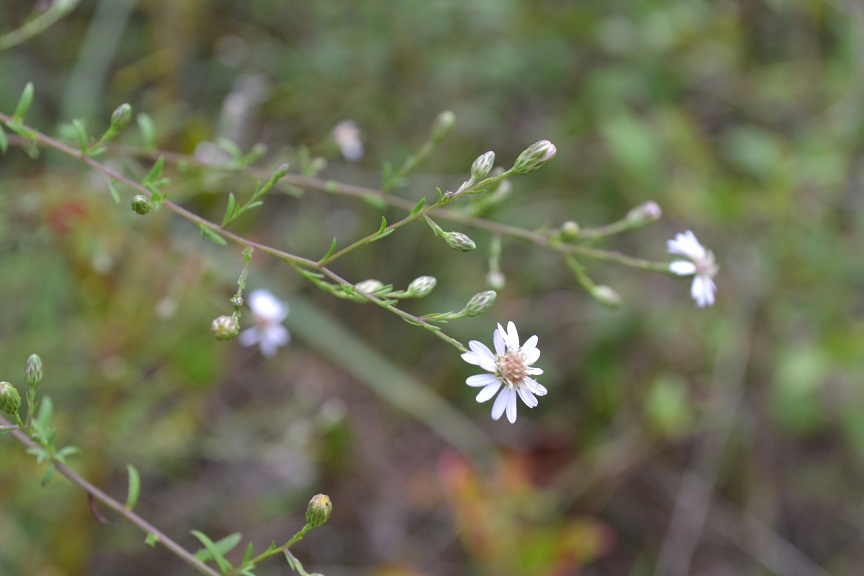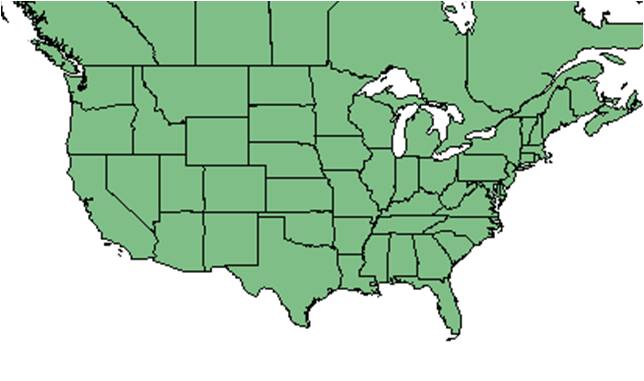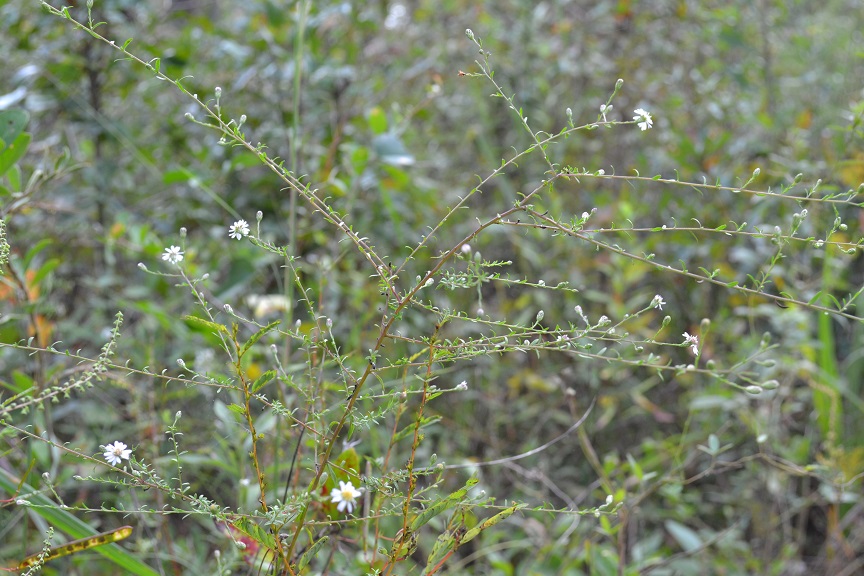Conyza canadensis
| Conyza canadensis | |
|---|---|

| |
| Photo taken by Kevin Robertson | |
| Scientific classification | |
| Kingdom: | Plantae |
| Division: | Magnoliophyta - Flowering plants |
| Class: | Magnoliopsida - Dicotyledons |
| Order: | Asterales |
| Family: | Asteraceae ⁄ Compositae |
| Genus: | Conyza |
| Species: | C. canadensis |
| Binomial name | |
| Conyza canadensis (L.) Cronquist | |

| |
| Natural range of Conyza canadensis from USDA NRCS Plants Database. | |
Common name: Canadian Horseweed; Common Horseweed
Contents
Taxonomic notes
Synonyms: Erigeron canadensis Linnaeus; Leptilon canadense (Linnaeus) Britton; Erigeron pusillus Nuttall; Leptilon pusillum (Nuttall) Britton; Conyza parva Cronquist; Conyza canadensis var. glabrata (A. Gray) Cronquist; C. parva Cronquist; Erigeron canadensis var. pusillus (Nuttall) B. Boivin The Flora of North America.
Varieties: Conyza canadensis (Linnaeus) Cronquist var. canadensis; Conyza canadensis (Linnaeus) Cronquist var. pusilla (Nuttall) Cronquist
Description
A description of Conyza canadensis is provided in The Flora of North America.
Distribution
Generally, C. canadensis is native across North America, from the continental United States to most of Canada. It is also native to Navassa Island, Puerto Rico, St. Pierre and Miquelon, and the U.S. Virgin Islands. The species has been introduced to Alaska, Hawaii, and the Pacific Basin.[1] As well, it was introduced to Europe in the 17th century.[2] Conyza canadensis var. canadensis is widespread, distributed from south Canada throughout the United States and into tropical America, whereas C. canadensis var. pusilla is distributed from southeast Massachusetts and Connecticut to south Indiana, down to Florida and Texas as well as into tropical America.[3]
Ecology
Habitat
It can be found in a range of habitats from old fields to dunes as well as gardens and disturbed areas.[3] C. canadensis is a common pest of agricultural fields, and can grow on a range of acidic to neutral soils (pH 4.8 to 7.2).[2] C. canadensis was found in the seed bank of scrub, longleaf pine, and ecotone habitats in the western panhandle region of Florida. [4]
Phenology
C. canadensis has been observed to flower in June.[5] Flowering season of C. canadensis var. canadensis is from July to November while flowering season of C. canadensis var. pusilla is from July to December as well as occasionally May to December.[3] Flowering in mid to late summer can be due to fall seed germination.[2]
Seed dispersal
This species is thought to be dispersed by wind. [6] It produces a large amount of seeds that can easily colonize disturbed soils through wind.[2]
Seed bank and germination
C. canadensis germinates from seed at any time of the year with sufficient warmth and moisture. If it germinates in the fall, it overwinters as a rosette and bolts in the spring to flower in the summer, whereas if it germinates in the spring, the individual spends less time as a rosette before it bolts to flower.[2]
Pollination
The following Hymenoptera families and species were observed visiting flowers of Conyza canadensis at Archbold Biological Station. [7]
Andrenidae: Andrena fulvipennis
Apidae: Epeolus carolinus
Halictidae: Sphecodes heraclei
Leucospididae: Leucospis affinis
Pompilidae: Episyron conterminus posterus
Sphecidae: Anacrabro ocellatus, Cerceris blakei, Ectemnius rufipes ais, Microbembex monodonta, Pluto rufibasis, Tachysphex apicalis, T. similis
Vespidae: Pachodynerus erynnis, Parancistrocerus salcularis rufulus, Stenodynerus beameri, S. fundatiformis, S. histrionalis rufustus
Use by animals
C. canadensis consists of approximately 2-5% of the diet for large mammals, but consists of approximately 10-25% of the diet for white-tailed deer.[8][9] Historically, Native Americans utilized the species for numerous ailments. The Seminole tribe used it for cold and cough medicine, the Navajo and Chippewa tribes used it for stomach pain, and the Iroquois tribe used it to help combat fevers.[2]
Conservation and management
C. canadensis is considered to be weedy or invasive in Kentucky, the Northeast, Nebraska and the Great Plains, the West, and Canada.[1]
Cultivation and restoration
Photo Gallery
References and notes
- ↑ 1.0 1.1 USDA, NRCS. (2016). The PLANTS Database (http://plants.usda.gov, 15 April 2019). National Plant Data Team, Greensboro, NC 27401-4901 USA.
- ↑ 2.0 2.1 2.2 2.3 2.4 2.5 Tilley, D. 2012. Plant Guide for Canadian horseweed (Conyza canadensis). USDA-Natural Resources Conservation Service, Aberdeen, ID Plant Materials Center. 83210-0296.
- ↑ 3.0 3.1 3.2 Weakley, A. S. (2015). Flora of the Southern and Mid-Atlantic States. Chapel Hill, NC, University of North Carolina Herbarium.
- ↑ Ruth, A. D., et al. 2008. Seed bank dynamics of sand pine scrub and longleaf pine flatwoods of the Gulf Coastal Plain (Florida). Ecological Restoration 26:19-21.
- ↑ Nelson, G. PanFlora: Plant data for the eastern United States with emphasis on the Southeastern Coastal Plains, Florida, and the Florida Panhandle. www.gilnelson.com/PanFlora/ Accessed: 8 DEC 2016
- ↑ Kirkman, L. Katherine. Unpublished database of seed dispersal mode of plants found in Coastal Plain longleaf pine-grasslands of the Jones Ecological Research Center, Georgia.
- ↑ Deyrup, M.A. and N.D. 2015. Database of observations of Hymenoptera visitations to flowers of plants on Archbold Biological Station, Florida, USA.
- ↑ Miller, J.H., and K.V. Miller. 1999. Forest plants of the southeast and their wildlife uses. Southern Weed Science Society.
- ↑ Gee, K.L., M.D. Porter, S. Demarais, F.C. Bryant, and G.V. Vreede. 1994. White-tailed deer: Their foods and management in the Cross Timbers. Ardmore.
